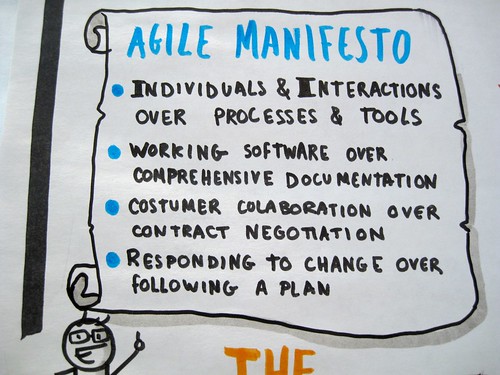Kanban methodology
Updated: Tue, 17 Mar 2015 by Rad
Kanban a Japanese manufacturing system in which the supply of components is regulated through the use of a card displaying a sequence of specifications and instructions, sent along the production line.
Kanban, at its core, is very simple.
- Visualize your work
- Limit your work in process
Kanban is a new technique for managing a software development process in a highly efficient way. Kanban underpins Toyota's "just-in-time" (JIT) production system. Although producing software is a creative activity and therefore different to mass-producing cars, the underlying mechanism for managing the production line can still be applied.
Kanban is incredibly simple, but at the same time incredibly powerful. In its simplest incarnation, a kanban system consists of a big board on the wall with cards or sticky notes placed in columns with numbers at the top.
Flexibility in planning
A kanban team is only focused on the work that's actively in progress. The product owner is free to re-prioritize work in the backlog without disrupting the team, because any changes outside the current work items don't impact the team. As long as the product owner keeps the most important work items on top of the backlog, the development team is assured they are delivering maximum value back to the business. So there's no need for the fixed-length iterations you find in scrum.
Efficiency through focus
Multitasking kills efficiency. That's why a key tenant of kanban is to limit the amount of work in progress (WIP). Work-in-progress limits highlight bottlenecks and backups in the team's process due to lack of focus, people, or skill sets.
Source: Pk refinement - Kanban chart, by PK-refinement1, flickr, License: Creative Commons
Source: Kanban sandwich, by commons.wikimedia.jpg, wikimedia, License: Creative Commons
Agile Manifesto
In February 2001, 17 software developers (see below) met at the Snowbird resort in Utah to discuss lightweight development methods. They published the Manifesto for Agile Software Development
"We are uncovering better ways of developing software by doing it and helping others do it. Through this work we have come to value:"
- Individuals and interactions over Processes and tools
- Working software over Comprehensive documentation
- Customer collaboration over Contract negotiation
- Responding to change over Following a plan
Source: Agile Manifesto, by visualpun.ch, flickr, License: Creative Commons
< back to glossary
Kanban - from around the web
- Kanban explained
- A brief introduction to kanban
- Kanban and Agile
- Agile Manifesto
- What Is Agile? (10 Key Principles of Agile)
- Agile methodology
< back to glossary


